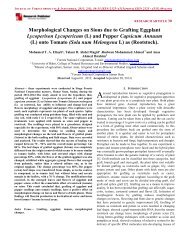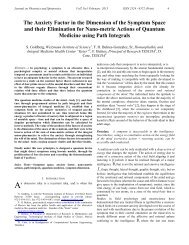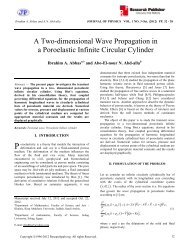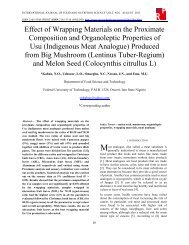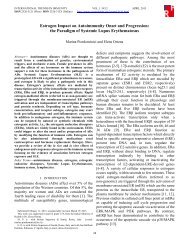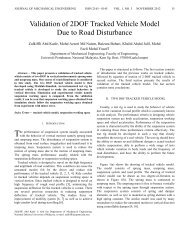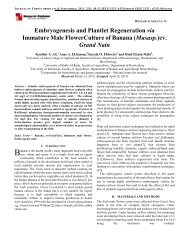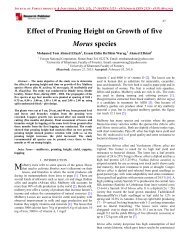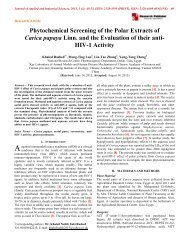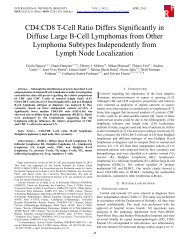(L) Seeds on Germination of Striga Hermonthica (Del.) Benth Seeds
(L) Seeds on Germination of Striga Hermonthica (Del.) Benth Seeds
(L) Seeds on Germination of Striga Hermonthica (Del.) Benth Seeds
Create successful ePaper yourself
Turn your PDF publications into a flip-book with our unique Google optimized e-Paper software.
JOURNAL OF FOREST PRODUCTS & INDUSTRIES, 2013, 2(4), 16-21 ISSN:2325–4513(PRINT) ISSN 2325 - 453X (ONLINE)19The results <strong>of</strong> the mean separati<strong>on</strong> test for the effect <strong>of</strong> differentwood pretreatments <strong>on</strong> compressive strength (Kg/cm 2 ) showedthat additi<strong>on</strong> <strong>of</strong> gypsum gave the highest value and wassignificantly different from all other treatments followed byc<strong>on</strong>trol, additi<strong>on</strong> <strong>of</strong> calcium chloride and soaking in cold water,between which no differences were found. Extracti<strong>on</strong> by NaOH1% was ranked last, and this may be attributed to the adverseeffect <strong>of</strong> the sodium in lowering the air dry density, in this studyincreasing density associated with better properties and this isgoes in total agreement with the finding <strong>of</strong> abdalgadir andIbrahim [2] who stated that the compressive strength is highlycorrelated with the density <strong>of</strong> wood cement mixture. Previousworks <strong>of</strong> Hassan [17] and Ibrahim [18] c<strong>on</strong>cluded that, additi<strong>on</strong><strong>of</strong> calcium Chloride help in improving the compressive strengthand ranked first, while in this study additi<strong>on</strong> <strong>of</strong> calcium chlorideranked sec<strong>on</strong>dly. Additi<strong>on</strong> <strong>of</strong> gypsum (20% -based <strong>on</strong> cementweight) increased the compressive strength more than 100%compared with the others treatments and displaced calciumchloride from the top rank. This may possibly be due toincreased air dry density. An exciting result was that soakingmesquite wood in cold water as well as c<strong>on</strong>trol shared the samerank with additi<strong>on</strong> <strong>of</strong> calcium chloride, which indicated thatmesquite wood can safely be used to produce cement b<strong>on</strong>dedproducts without any sort <strong>of</strong> treatment. This may be attributed tothe fact that the extractives present in mesquite wood did nothave an inhibitory effect <strong>on</strong> cement setting.As shown in Table 2 the results <strong>of</strong> the mean separati<strong>on</strong> test forthe effect <strong>of</strong> wood pretreatment <strong>on</strong> the water absorpti<strong>on</strong>percentage <strong>of</strong> mesquite wood – cement b<strong>on</strong>ded aggregates.,additi<strong>on</strong> <strong>of</strong> gypsum, additi<strong>on</strong> <strong>of</strong> calcium chloride and c<strong>on</strong>trolsgave the best result when soaked for two hours and were notsignificantly different from each other, but were significantlydifferent from soaking in cold water and soaking in 1% sodiumhydroxide soluti<strong>on</strong> (Table 2). But when soaking was extendedto 24 hours, additi<strong>on</strong> <strong>of</strong> gypsum and additi<strong>on</strong> <strong>of</strong> calciumchloride significantly improved water absorpti<strong>on</strong>, while c<strong>on</strong>trolranked third, but not significantly different from additi<strong>on</strong> <strong>of</strong>calcium chloride. Soaking in 1% sodium hydroxide soluti<strong>on</strong>opposite was true. The results <strong>of</strong> mean separati<strong>on</strong> test for theeffect <strong>of</strong> cement/ wood ratio <strong>on</strong> water absorpti<strong>on</strong> are shown in 7revealed that, significant differences between the ratios wereobserved when the specimens were soaked for 2 hours, with thetrend that as cement wood ratio increased water absorpti<strong>on</strong>decreased. This result goes in total agreement with the finding<strong>of</strong> Elten [21] who found that the water absorpti<strong>on</strong> tended todecrease as the amount <strong>of</strong> cement was increased from 50:50 to30:70. Obviously, a higher wood c<strong>on</strong>tent (lower cement: wood:ratio), would result in greater water absorpti<strong>on</strong> due the nature <strong>of</strong>wood which will be less surrounded by cement, but increasingthe cement ratio results in better coating <strong>of</strong> wood particles. Thisprevents them from absorbing water. There were alsosignificant differences between ratios when specimens weresoaked for 24 hours, which indicate that the aggregatesshowed the highest percentage <strong>of</strong> water absorpti<strong>on</strong>. Generallypretreating any hardwood improves water absorpti<strong>on</strong>percentage due to improvement <strong>of</strong> cement setting c<strong>on</strong>diti<strong>on</strong>s.Previous work by Hassan [17] and Ashraf and abdalazim [5]c<strong>on</strong>cluded that the additi<strong>on</strong> <strong>of</strong> calcium chloride significantlyimproved water absorpti<strong>on</strong> percentage. However additi<strong>on</strong> <strong>of</strong>gypsum in this study showed better aggregate performance thanadditi<strong>on</strong> <strong>of</strong> calcium chloride.Effect <strong>of</strong> cement/wood ratios <strong>on</strong> the density <strong>of</strong> mesquitewood/cement b<strong>on</strong>ded aggregatesMean separati<strong>on</strong> test results for the effect <strong>of</strong> cement wood ratio<strong>on</strong> mesquite wood-cement b<strong>on</strong>ded aggregates air dry density,compressive strength and water absorpti<strong>on</strong> percentage (2 and 24hours) were presented in Table 3. Regarding air dry density, nosignificant differences were observed between ratios 4:1 and5:1which gave the highest value. But there were significantdifferences between the other ratios. As expected increasingcement/wood ratio results in increased aggregate air dry densitysince additi<strong>on</strong> <strong>of</strong> more cement means increasing the specimenweight. The same c<strong>on</strong>clusi<strong>on</strong> was found by Zhou and Kamdem[19] who stated that, cement-b<strong>on</strong>ded particleboard that utilizelarge amounts <strong>of</strong> cement in comparis<strong>on</strong> to wood (cement: woodratio higher than 3:1), result in final product with high density(>1300 kg/m 3 ), because cement is denser than wood. AlsoOyagade et al., [20] reported that veneer laminatedcement-b<strong>on</strong>ded particleboard were str<strong>on</strong>ger and stiffer withincreased cement/wood ratio due to increased density.As shown in Table 3 significant differences were foundbetween the four studied ratios regarding compressive strength.As observed from the Table 3 increasing cement: wood ratioresulted in increasing compressive strength. This can beattributed to the increased air dry density. This goes in totalagreement with the finding <strong>of</strong> Abdelgadir and Ibrahim [2] whoc<strong>on</strong>cluded that compressive strength <strong>of</strong> cement- wood mixturefor five Sudanese hardwood species is c<strong>on</strong>siderably reduced ascement/wood ratios were decreased and theabsorbed huge amount <strong>of</strong> water during the first hours <strong>of</strong> soaking,while increasing the soaking time result in <strong>on</strong>ly a fewpercentages <strong>of</strong> increase (3-6%). which agreed well with thec<strong>on</strong>clusi<strong>on</strong> <strong>of</strong> Hassan [17] who c<strong>on</strong>cluded that soaking in waterfor 24 hours increased the amount <strong>of</strong> water absorpti<strong>on</strong> by anaverage <strong>of</strong> 6% compared to soaking for 2 hours. From all abovementi<strong>on</strong>ed results, it may be c<strong>on</strong>cluded that aggregates with lowcement wood ratio absorb more water and possesses lowercompressive strength. However, aggregates with highercement/wood ratio (4:1 and 5:1) absorb small amount <strong>of</strong> water,possesses higher compressive strength and heavy weight (highdensity). The aggregate produced with cement wood ratio <strong>of</strong> 3:1had reas<strong>on</strong>able weight, good strength and reliable density. Theoverall c<strong>on</strong>clusi<strong>on</strong> is that 3:1 cement wood ratio is the suitableand recommended ratio to be used for untreated mesquite wood.



